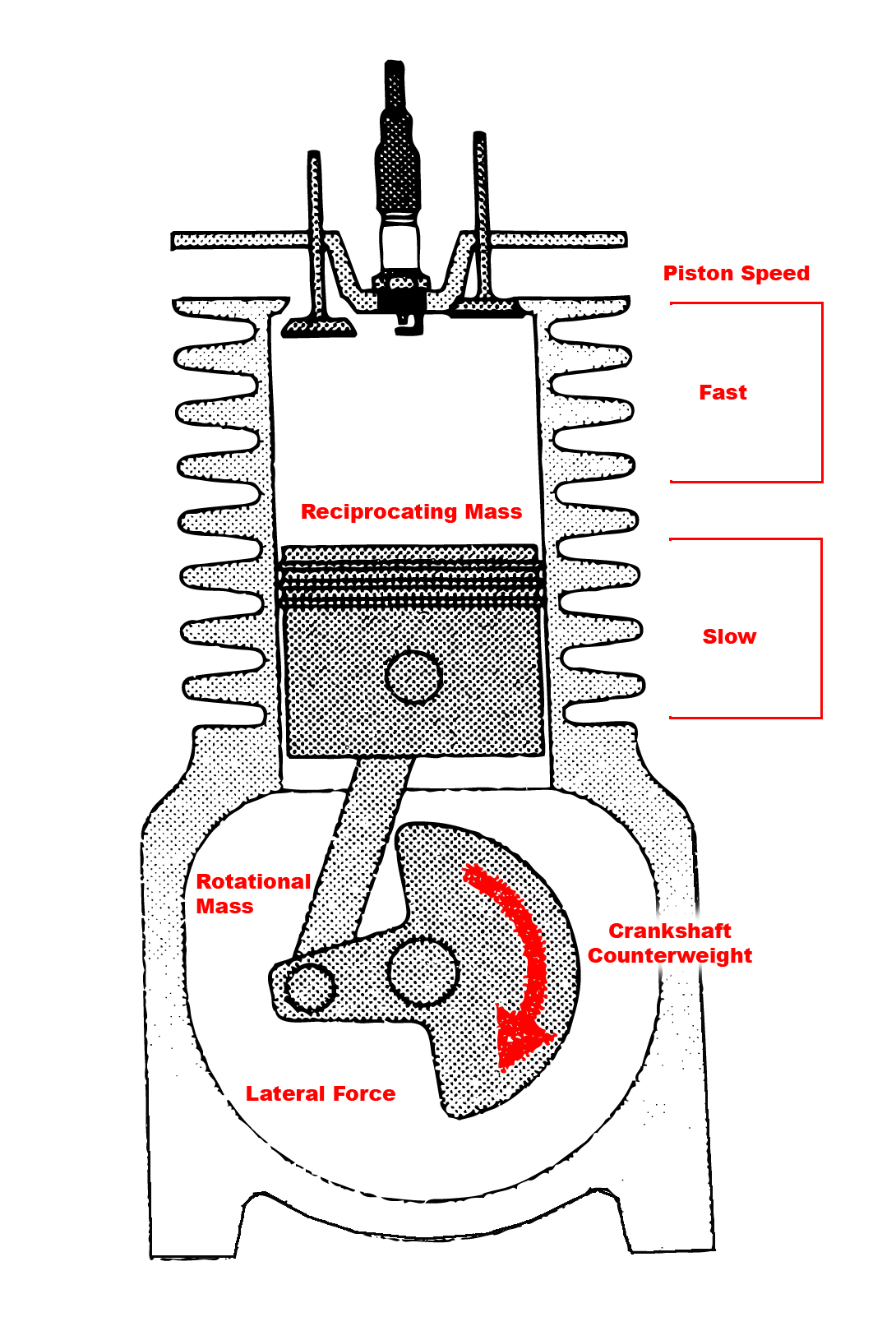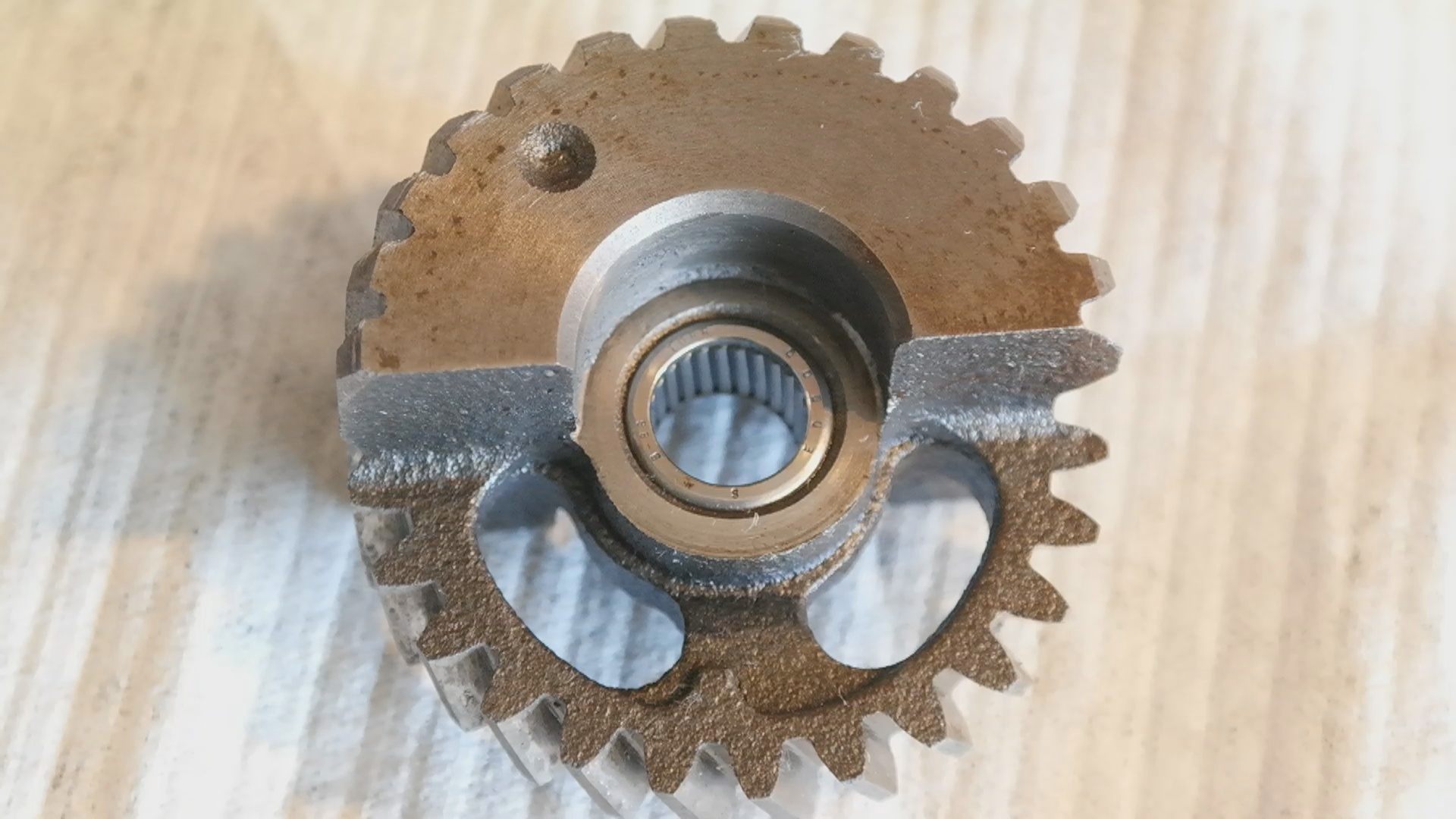Engine Science: The Balancing Act of Single Cylinder Engines
You may have heard of the term “grenade gears” when researching the Kohler K series engines. Even I have heard many people proclaim they throw the balance gears out when rebuilding their engine, and that they don’t do anything anyways. When asked why, people often site some anecdotal evidence of gear failure they heard through an internet forum. It seems to me that few small engine enthusiasts understand why balance gears exist, why they are important, and what causes premature failure. I hope this article can help you make an informed choice when rebuilding your engine.
Masses in Motion
The purpose of an internal combustion engine is to transform chemical energy into mechanical energy. This is accomplished by igniting an air/fuel mixture that causes a shaft to rotate. We then use this rotating shaft to create useful work.
In order to turn a shaft with combustion, we need to convert not only chemical energy, but we need to convert a reciprocating motion into a rotational motion. The reciprocating motion is the engine’s piston moving up and down, and the rotational motion is the crankshaft turning. As you can imagine there is a lot of things moving all at once with drastic changes in direction and speed. This process generates a lot of unwanted vibration and movement as a by-product.
The masses in motion can be separated and simplified by referring to them as a reciprocating mass and a rotational mass. The reciprocating mass is the piston, piston rings, wrist pin, and small end of the connecting rod. The rotational mass is the big end side of the connecting rod and the crankshaft itself.
Primary, Secondary, and Lateral Forces
There are three kinds of forces at play I will discuss for this article: Primary Force, Secondary Force, and Lateral Force.
Primary Force is created when a big mass like the piston is moving up and down in an engine. Without a way to counteract that up and down motion, the engine would buck and jump wildly during operation.
The Secondary Force is created because the piston moves at two different speeds throughout its 360 degree rotation. The piston will move faster in the upper half of the cylinder during rotation from 0 degrees and 90 degrees and 270 degrees and 360 degrees; and slower in the bottom half of the cylinder during rotation from 91 degrees and 269 degrees.
Lateral Force is created when the crankshaft is at 90 and 270 degrees in its rotation. The piston is low and the crankshaft rod journal is at a lateral plane. The crankshaft’s counterbalance weight is not directly opposed and cancelled out by the piston.

How Single Cylinder Engines Balance these Forces
Single cylinder engines are unique in the sense they cannot rely on other pistons or a particular firing order to help balance the force an engine produces. Instead, single cylinder small engines rely on a crankshaft counterweight machined into the crankshaft, and other counterbalancing gears connected to the crankshaft.
The crankshaft counterweight is normally designed to be a specific percentage of the weight of the Piston, Rings, Wrist Pin, and Connecting rod of that particular engine. The counterweight is on the opposite end of the crankshaft’s rod journal and is designed to counter act and cancel out the movement of the piston when it is coming down and up in the cylinder. When the piston is at the top of the cylinder, the crankshaft counterweight is in the exact opposite position in its bottom position. When the piston is at the bottom of the cylinder, the crankshaft counterweight is in its top position.
This counterweight does a great job at balancing the primary force of the engine. However when the crankshaft is at 90 degrees and 270 degrees of rotation, the counterbalance is not opposite any of the reciprocating mass. This unbalance now creates a lateral vibration effect on the engine. This lateral vibration can be balanced with a set of counter-balancing gears.
All of the major small engine companies such as Kohler, Briggs and Stratton, and Tecumseh used a counterbalance gear system in an effort to produce a smoother running single cylinder engine. Balance gears are an imbalanced set of gears that rotate in the opposite direction of the crankshaft and in such a way so that their heavier side is opposite the crankshaft counterweight during the lateral vibration at 90 degrees and 270 degrees, and also so that they oppose the piston at 0 and 180 degrees.
By rotating in the opposite direction of the crankshaft, and by adding their counterweight at the correct time, balance gears help in reducing the lateral vibration, and help balance the secondary forces of the engine.


Kohler K Series Balance Gear Briggs and Stratton Balance System
The Benefits of a More Balanced Single Cylinder Engine
Balancing an engine is not only for operator comfort. By reducing unwanted vibrations and movement, less energy is wasted and thus more can be converted into useful work in the form of horsepower. Other benefits include reducing wear on the main bearings, nuts, and bolts that hold your engine and tractor together.
Preventing Premature Failure
Anything that rotates in an engine is subject to wear and failure. Balance gears typically ride on shafts pressed into the engine block. Inside the gears are typically needle bearings. When servicing your engine’s counterbalance system, make sure you check the gears’ shafts and bearings for wear. Replace if they are not within the manufacturer’s specifications. Check endplay with a feeler gauge and correct when needed.
I hope this article helps you understand the balancing act that goes on in your engine. This article just scratches the surface of the subject, but I hope it helps you keep your tractors and engines running for another lifetime.
Thank you for saving the tractors.
- -Norman
Recent Posts
-
A Letter From the Owner of iSaveTractors
Dear Friends and Fellow Tractor Enthusiasts, After over a decade of serving the vintage small engine …Jun 5th 2025 -
Rebuild your Old Kohler K Series Engine vs Buying New
Why Rebuilding Your Old Kohler K-Series Engine Beats Buying a New Mower or Engine In today’s throwaw …May 13th 2025 -
iSaveTractors vs Cheap Parts from Amazon
Why iSaveTractors Parts Outshine the Cheap Alternatives on Amazon When it comes to restoring and mai …May 12th 2025

